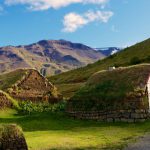With port stops in charming, snow-topped, and naturally stunning spots like Ny-Alesund, Spitsbergen, Norway – Akureyri, and Iceland, there are plenty of incredible sites to see in the Arctic.

While the Arctic Circle is practically synonymous with snow, temperatures in summer can be surprisingly warm, reaching as high as 86 °F inland. Depending on when you go, you may see tons of snow or you might get to witness the lush landscapes that make summer in the Arctic so special.
Here are a few of our favorites:
Liefdefjorden (Liefdef Fjord)
A fjord is a narrow, deep inlet that allows the sea – and your cruise ship – to sneak between two high cliffs. They’re rather common in areas like Iceland and Norway, where glaciers carved deep valleys into what eventually became the ocean floor.  These days, fjords are breathtaking examples of what Mother Nature is capable of creating. Liefdefjord goes by many different names, but whatever you choose to call it, the walls of ice and brilliant reflective qualities of the crystal clear surrounding water are nothing short of awesome.
These days, fjords are breathtaking examples of what Mother Nature is capable of creating. Liefdefjord goes by many different names, but whatever you choose to call it, the walls of ice and brilliant reflective qualities of the crystal clear surrounding water are nothing short of awesome.
The Northern Lights
The Northern Lights, also known as the Aurora Borealis, are a naturally occurring phenomenon that results from the reaction between electrically charged solar particles and the earth’s atmosphere. The lights are best seen above the magnetic poles (both north and south) and they can range in shade from red to yellow, to green to blue and even a striking violet.  The lights take many different shapes, as well; at times they illuminate the sky with almost an eerie glow while at other times they streak like neon fingers across the sky, making laser-like shapes and leaving vivid curtains of color in their wake.
The lights take many different shapes, as well; at times they illuminate the sky with almost an eerie glow while at other times they streak like neon fingers across the sky, making laser-like shapes and leaving vivid curtains of color in their wake.
Arctic Wildlife
While many people associate arctic areas with solitude and isolation, there is a great variety of wildlife that call the locale home. Polar bears strut across ice caps, dipping their colossal paws into the ocean in hopes of snagging some supper.  There are walrus and seals frolicking about, Arctic foxes skirting the terrain, and huge colonies of seabirds that emerge en masse from the cliff sides and stark islands where they make their nests. Depending on how close your ship gets to land while sailing and where you make port, you may also see whales, caribou, reindeer, and the majestic snowy owls.
There are walrus and seals frolicking about, Arctic foxes skirting the terrain, and huge colonies of seabirds that emerge en masse from the cliff sides and stark islands where they make their nests. Depending on how close your ship gets to land while sailing and where you make port, you may also see whales, caribou, reindeer, and the majestic snowy owls.
The Midnight Sun
Summer in the Arctic Circle brings a unique event called the Midnight Sun. Around June 21, also known as the summer solstice, the sun begins to visible 24 hours a day. This round-the-clock sunlight can be off-putting for some but many people find it almost magical.  The length and visibility of the Midnight Sun vary from year to year and location to location; the northernmost part of Finland may see the sun for 60 days straight during summer while in Svalbard, Norway, the sun doesn’t set from mid-April to late August. There is also a similar phenomenon in winter, called Polar Night, where the sun hides below the horizon line, plunging the area into constant darkness.
The length and visibility of the Midnight Sun vary from year to year and location to location; the northernmost part of Finland may see the sun for 60 days straight during summer while in Svalbard, Norway, the sun doesn’t set from mid-April to late August. There is also a similar phenomenon in winter, called Polar Night, where the sun hides below the horizon line, plunging the area into constant darkness.
Windswept Scenery at Spitsbergen
The Svalbard archipelago is a group of islands slung between the mainland of Norway and the North Pole. The area is largely uninhabited by man, leaving plenty of room for the local herds of reindeer to meander about, but the capital of Longyearbyen boasts a healthy population of about 2,000 people.  You can learn more about the islands by stopping into the Svalbard Museum, where displays tell the story of Spitzbergen’s 400-year history. The museum offers fascinating insights into life and geological points of interest in the Arctic – Norway in particular – but still, most people spend their time in Spitsbergen outdoors. Grab a guide (you’ll want one who knows the lay of the land and how to avoid polar bears) and go on a glacier walk or try out dog-sledding.
You can learn more about the islands by stopping into the Svalbard Museum, where displays tell the story of Spitzbergen’s 400-year history. The museum offers fascinating insights into life and geological points of interest in the Arctic – Norway in particular – but still, most people spend their time in Spitsbergen outdoors. Grab a guide (you’ll want one who knows the lay of the land and how to avoid polar bears) and go on a glacier walk or try out dog-sledding.
Visit our Arctic page to see cruise options in this beautiful region.



